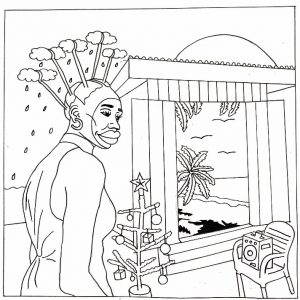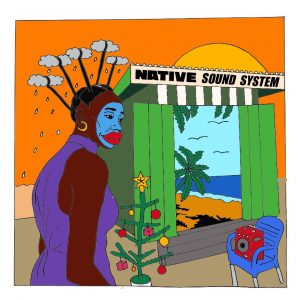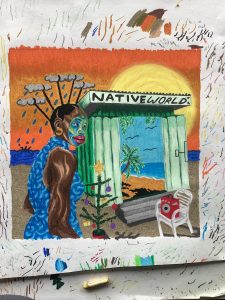NCVRD: How Sinalo Ngcaba Created NATIVE Sound System’s ‘NATIVEWORLD’
the South African artist reveals her roots
the South African artist reveals her roots
Whenever Sinalo Ngcaba paints, she listens to music. Her tastes are varied but often pull close to home—seventies Soul, Funk, Rock, Hip-Hop, African pop music. It is home because Sinalo is proudly South African, spending her early life in the country’s region of East London. It’s also where her visual work began to take shape, find community, and become an integral part of her identity as a Black woman. She already had an enviable portfolio, then came the request for her to create the art cover for a seminal music album.
The Native Sound System’s ‘NATIVEWORLD’ has been in the works since last year, its sonic texture built around the different weather seasons in Nigeria. Black musicians from several African countries, the United Kingdom and US united in recording camps, working creatively with the NSS team to bring its vision to life. When the album appeared in mid August, it was as unprecedented as you’d expect. Colourful songs cut from the tapestry of diaspora-suffused Afropop provided Sinalo rich material to draw from. “It was easy for me to put stuff together into this project,” she said to The NATIVE on a recent weekday. “I was listening to it a lot and it inspired me to create the work.”
View this post on Instagram
The NSS team had given her background information on the seasons, and Sinalo did additional research to complement what she knew. If you look at the cover, there’s a visceral nature to its shades—this is because Sinalo created the front and back covers traditionally using oil painting, while others were made digitally using Procreate. “When I create stuff, I want to look at it and I want to feel better,” she says about her choice of using bright colours. “[They] evoke such emotion and usually, the brighter the colour, the brighter the mood you get from it. Some people also, when they look at my work it makes them smile, with the colours and the type of imagery I use.”
The cover reveals an artist immersed in the peculiarities of her craft. Even though colours abound, the details are neatly finished and yet retain some rudimentary roughness, a precursor to the pleasant surprise contained in the album. A door bearing the word ‘NATIVEWORLD’ is painted light green, the sea behind promising escape. Leaves from a coconut tree peeks out from the other side, a music box seated on a chair, as if to say, take your listening device and step into bliss.
Compared to the small town of East London, the city of Johannesburg—which is affectionately called Joburg by residents—is a bustling place. Its industrial allure has brought people from far and near into its space, contributing to the myriad flavours of its local culture. In the words of Sinalo, “You see different cultures, hear different languages, you experience different things, all in one city. So that also inspires the brightness of my work. It’s from, like, the explosion that I see when I’m out in the streets.”
Sinalo also draws from the protest tradition of South African artists. Inspired by the darkened history of the nation’s Apartheid, a lot of creators in the decades after—from filmmakers to writers and visual artists like Sinalo—have proven eager to render their voices to that recent history, and as well speak against contemporary outbreak of oppressive regimes, particularly across Africa.
In 2020, she was very vocal about the gross human rights infringements happening in Zimbabwe under the presidency of Emmerson Mnangagwa. She created stirring images, replete with colours and raised fists, the swung boots of policemen on citizens, and mocking figures dragging a body in the street. Of her artistic ethos and approach, she credits the iconic Medu Art Ensemble as an inspiration. “They used to do political artworks and posters during Apartheid, so in terms of layout, I’m very much inspired by the way they would use bold colours and bold text, which I like to do sometimes as well”.
View this post on Instagram
She also addresses social issues in her work. “I talk about gender-based violence ‘cos South Africa has the highest cases in the world, so as a Black woman living here it’s very hard for us,” she says, her tone now heavy with deliberation. “It’s always been happening—whether it’s rape, abducted, or violence towards us so in my work sometimes I do talk about that because it’s a problem that faces me, my mother, every female person in my life, we go through the same thing so I feel like it’s also my responsibility. Even though it’s not comfortable, it’s what we’re living, it’s real life.”
In one of her paintings, she evokes a barbershop as she uses red lines to map figureheads of two men—a teenager, a man in his thirties or about, and the inscription, ‘hurting women has never been in style’. In another, she contrasts images of protest within a red map-ish constriction, while a smattering of blue rests outside the heated centre. ‘Don’t forget your first home was a woman,’ read this one. She’s as inspired by her contemporaries as much as forebears—Natalie Paneng, Talia Ramkilwan, Qhamanande Maswana, Nombuso Dowelani and Dada Khanyisa are some names Sinalo sent later to me in a private message.
View this post on Instagram
Sinalo has come a long way with art. Her love for visual expression began way back, in primary school where she would draw her classmates. In high school, she took Design as a subject. “I’ve done it most of my life,” she says. And she does it really well too, which is why she stands where she is today: among the most skilled and visible artists in the scene.
It wasn’t a hitch-free journey however, even the talented have to find their space for freedom. After college she worked as a graphic designer for a property company, but it was very corporate and she didn’t have a lot of creative stuff to do. She quit and became independent, making art and sharing online. “That’s how I started getting clients,” she shares, “People would ask, ‘hey, can you do this and that’ and that’s how I started off professionally.”
View this post on Instagram
That was only 2020, and it’s testament to Sinalo’s forward-thinking vision that she’s already diversifying her creativity. While visually driven work occupies the heart of her art, the medium of depicting them can be anything. Sinalo has collaborated with Levi’s to create a designed jacket, printed her art on a shirt for Creative Nestlings, and she’s launching her own merchandise soon. “I’m not a huge fashion person but I like things I like,” she says with a half-laugh. “I think another way to push my art is to put it on different types of clothing. I think it would look really cool”.
Firmly rooted in the artistic ethos of Sinalo, is accessibility. “I see my art being in places where art isn’t easily accessed. ‘Cos one side of my family is from the village and there isn’t a lot of art there. Art nowadays is accessible at galleries and stuff, where people dress fancy and talk fancy words. I feel like art should be more accessible like back in the day where Africans were super artistic. It was everywhere. So I’d like my art to reach those places that don’t usually get that platform, even maybe help artists who are there and don’t know the art world and how to sell artworks in this day and age. All of that.”
She has featured in the group exhibitions by Afropunk and Umuzi in 2018, and two years later was among the artists on Between 10and5 online exhibition and auction. Sinalo’s profile is rising: later this year, she’ll hold her first solo exhibition at the Bubblegum Club Residency Exhibition, expectedly in October. You should watch out for that.




